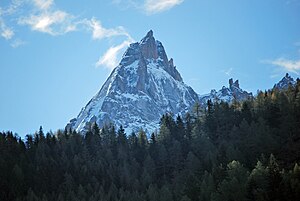Aiguille de Blaitière
| Aiguille de Blaitière | ||
|---|---|---|
|
Aiguille Blaitiere from the north. John Ruskin , ca.1856 |
||
| height | 3522 m | |
| location | Haute-Savoie , France | |
| Mountains | Mont Blanc massif , western Alps | |
| Coordinates | 45 ° 53 '56 " N , 6 ° 53' 56" E | |
|
|
||
| Type | Rock peaks | |
| rock | granite | |
| First ascent | 1874 | |
| Normal way | Spencercouloir, UIAA III , 51 ° | |
|
View of the west face of the Aiguille de Blaitière from Chamonix, right: Aiguille des Ciseaux and Aiguille du Fou |
||
|
The traces of the rockfalls of 1947 and 1952 can be clearly seen as bright spots in the rock. |
||
The Aiguille de Blaitière is a 3522 m high mountain near Chamonix in the French Mont Blanc massif .
topography
The Aiguille de Blaitière rises southeast of Chamonix above the glacier Glacier de Blaitière . It is part of the rugged mountain ridge of the Aiguilles de Chamonix , which extends here from the Aiguille du Midi in the southwest to the Aiguille des Grands Charmoz in the northeast. In the southeast, the Glacier d'Envers de Blaitière flows towards the Glacier du Tacul , a tributary of the Mer de Glace . To the northeast, a distinctive firn gully , the Spencercouloir , flows down to the Glacier des Nantillons . Well-known neighboring peaks are the Aiguille du Plan ( 3673 m ) in the southwest and the Aiguille du Grépon ( 3482 m ) in the northeast. To the south are the Aiguille des Ciseaux ( 3479 m ) and the Aiguille du Fou ( 3501 m ).
The Aiguille de Blaitière itself has three different peaks , the highest of which is the 3522 m high central peak . The north summit, also called Pte. de Chamonix , has a height of 3507 m , the south summit is about 3521 m high.
Alpinism
The Aiguille de Blaitière was ER Whitwell and C. and J. Lauener on 6 August 1874 first ascents , in 1873 TS Kennedy, JAG Marshall, J. Fisher and had U. Almer reached the North summit. The climbs chosen in the 19th century led over the rocks of the main ridge and along the edge of the Spencercouloir. They are hardly of any importance today. Today's normal route is the route over the Spencercouloir, which was first climbed in 1898 , which is through approx. 51 ° steep ice and rock climbing in the III. Difficulty level (UIAA) leads from the northeast to the summit.
The routes through the steep west face, most of which have the character of sport climbing routes , are also popular. Some of these routes are at risk of falling rocks . Only 20 days after the first ascent of the west face by P. Allain and A. Fix on September 10, 1947, a huge rock fall wiped out the new route completely. A new route opened in 1952 was also completely destroyed by a rock fall just one year later. The traces of these events can still be seen today and the affected wall sections can no longer be climbed. The best-known ascent through the west face today is the Engländerführe (VII), opened in 1954 by Joe Brown and Don Whillans . The Pilier rouge de Blaitière off the west face also offers several difficult sport climbing routes.
Another popular route is crossing the three Blaitière peaks, the Aiguille des Ciseaux and the Aiguille du Fou (V).
Starting points for the ascent are the middle station of the Aiguille du Midi cable car ( Plan de l 'Aiguille , 2310 m ), Montenvers or Chamonix.
literature
- Hartmut Eberlein: Alpine Club Guide Mont Blanc Group . 7th edition. Bergverlag Rudolf Rother , Munich 1991, ISBN 3-7633-2412-7 , p. 237-245 .
- Gaston Rébuffat : Montblanc . BLV, Munich 1975, ISBN 3-405-11485-3 , p. 96-97, 174-175 .
Web links
- Aiguille de Blaitière at Summitpost.org



